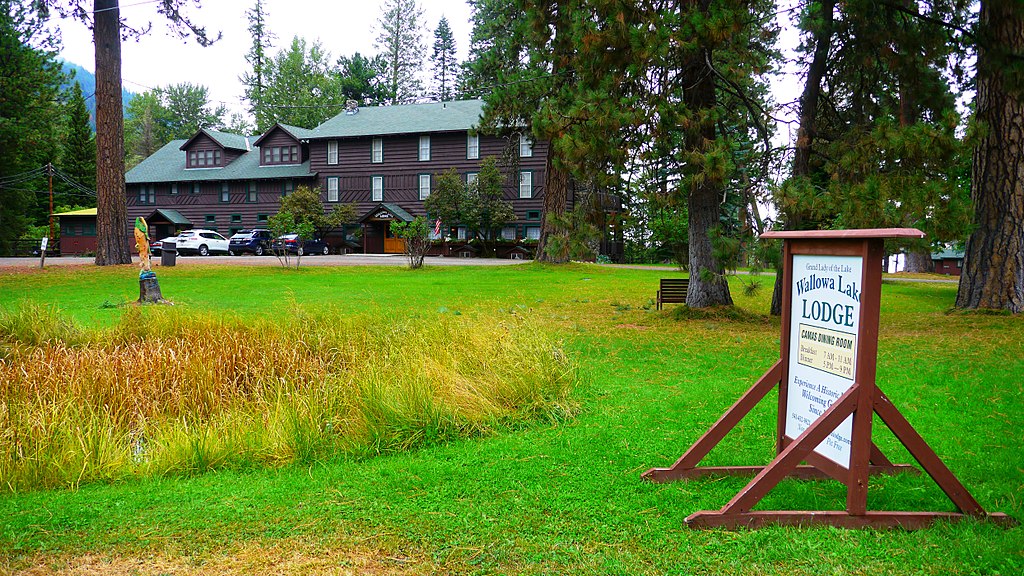Just down the hill from us, the Wallowa Lake Lodge is celebrating its 100th anniversary this weekend. The Seattle Times carried a good story about the Lodge and how it was “saved” by the local community in 2018. We were part of that, kicking in a couple thousand dollars to keep the Lodge from being torn down.
At the time, the 9-plus-acre property of the Lodge, bordered on the west by the Wallowa River and on the north by river’s entry into Wallowa Lake, was zoned for half a dozen “luxury homes” and 52 units of vacation condos. So the effort to save the Lodge was not only to preserve the Lodge, but to keep the property from being, as the euphemism has it, “developed.” These days the Lodge seems to be doing well as a business proposition and is more tied into the local community than in the past. We’ll cruise down there this evening to take in the live music that kicks off the big weekend.
In a related story, but not touched on in the Times report, last year the Lodge’s ownership group ceded the acreage to the Nez Perce Tribe, placing the property in a Land Trust for preservation. Related to this the Tribe, a major player in the local fishery, is allowing the river to find its own more natural channels into the Lake.
From the ’50s through at least the ’70s it was popular to “channelize” rivers up here, meaning use a bull-dozer to cut one deeper, straight channel to reduce high-water flooding. But that came at a cost to natural and fish habitat. Also precious water runs off much faster without sifting down to the aquifer. The new direction in river management means more habitat for fish, particularly the Kokanee salmon that spawn upriver each autumn from the lake. The river has more meanders now for salmon and trout. While it may flood its banks occasionally, it moves slower and with less erosive force.
At the north end of the lake (the Lodge is at the South End) the century-old dam that impounds the lake is slated to be rebuilt. The dam is a key part of the irrigation system for farm land in the Wallowa Valley to the north. It had been hoped that a new dam would include a fish ladder so salmon that spawn in the Snake and Grande Ronde systems might get back to the Lake itself, as they once did by the thousands. Now, it sounds like instead of a fish ladder, there will be a capture-and-haul system for salmon that make it through all the dams between here and the Pacific Ocean. Change is slow and sometimes painful. One great thing about the involvement of the Nez Perce is that they take the long view, having been here more than 10,000 years.
The last two mornings I have volunteered as a “Trail Ambassador” with the Wallowa Mountain/Hell’s Canyon Trails Association. That means I set up a card table at the trail head, lay out maps and guide books, don my official ambassadorial garb of vest and hat, and answer questions about hiking the in the Eagle Cap Wilderness Area. Thursday morning between 9 am and noon, I had 66 people stop by. Most were doing day hikes. Today my count was up to 100, with probably 40% beginning back-packing trips. Makes sense as we’re into a sunny and warm stretch as well as the long July 4th weekend.
During the pandemic, the Eagle Cap Wilderness area got very busy, at least on the main trails and to the most well-known of the High Lakes. I guess people were looking to “get away” and some other choices weren’t available. That influx subsided a bit last year, but it remains a popular place fueled by the promotions by Oregon State Tourism, and by “discovery” articles in Seattle Times, the Oregonian, Sunset and Outdoors magazines, and even the New York Times. We lament the publicity, but no one asked us. Besides, I’m kind of doing it myself. That’s the funny thing about the sins for which you judge others; it often turns out that you aren’t as innocent as you think you are!

Anyhow, the Trail Ambassador work is fun and a good fit for me as I’ve been hiking and backpacking in the Wallowa Mountains for seven decades. I know these trails pretty well.
Some people who head into the Eagle Cap are experienced, but many are first-time visitors. In the last two days I’ve met a lot of people from the Midwest who marvel at the mountains and clear, rushing rivers. I get it, if you’re from Kansas, these mountains (maybe any mountains) are pretty stunning. Today a group of 10 young men from Indiana came out after their four-night, 35-mile backpack trip.
They had gone over the very rugged “Polaris Pass,” which I hiked a couple years ago and promised myself not to do again. They were pretty wiped out. I tried to reassure them by saying that Polaris Pass is a “righteous hike” and they could be proud of themselves. They mostly had the “just give me a burger, a beer, and a shower” look. I’ve been there! (photo at right, on the trail in Eagle Cap.)
Discover more from Post Alley
Subscribe to get the latest posts sent to your email.

I enjoyed this story, Tony. Clearly, very personal for you. Thanks for sharing.